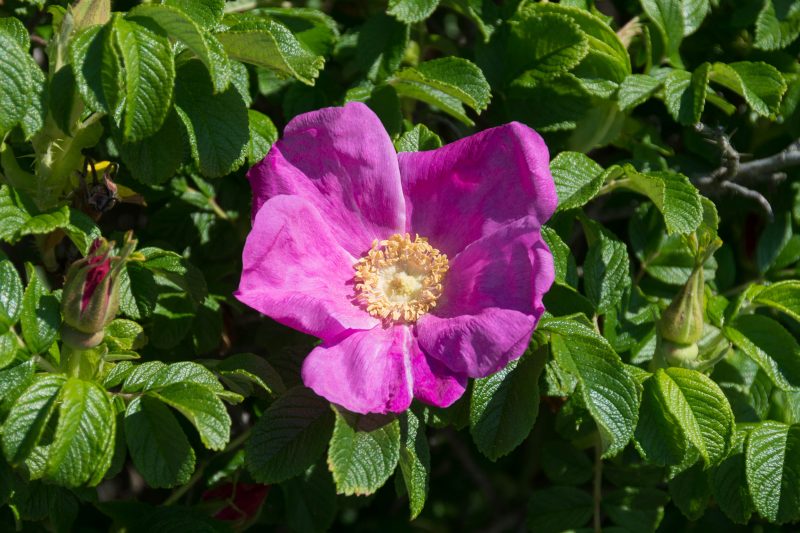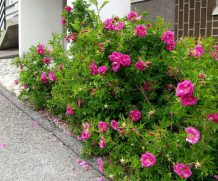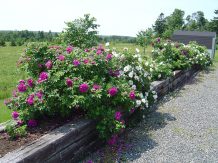Rosa Rugosa does not require painstaking care, and colorful flowering has made her one of the most popular ornamental plants for a personal plot.
Material Content:
Description of varieties and nuances of growing
Rosa rugosa has many varieties and hybrids, and each of them is beautiful in its own way. One of the varieties most beloved by gardeners is the Grootendorst, which was bred back in 1918. The variety blooms with charming bouquets, in which 20 bright raspberry flowers with a weak aroma are collected.

"Pink Grootendorst" is another favorite variety of this flowering rosehip. The shrub has a pyramidal shape and can grow to a height of one and a half meters. It blooms with pink flowers, whose petals have carved edges.
Even among our gardeners, varieties are very popular:
- "Suprem" blooming with raspberry inflorescences;
- White Grootendorst, which blooms with pure white inflorescences;
- "Anes" blooming with yellow flowers;
- "George Ken", characterized by very large inflorescences.
- ... and many other rose varieties of Rugosa.
This ornamental shrub is highly resistant to winter and tolerates drought. The plant is ideal for decorating parks and gardens due to its unpretentiousness and long flowering period.
Rosa Rugosa does not need frequent watering, she does not need regular top dressing. The only thing a grower needs to do is cut the branches of the bush and remove the faded buds so that the plant does not lose its decorative effect.
Choosing Healthy Seedlings When Purchasing
In order to grow a healthy and beautiful bush of flowering rose hips, it is first necessary to correctly select planting material.

Rugosa seedlings can either be grafted, or have their own rhizome (that is, be grown by cuttings).
When choosing, it is worth listening to the following tips:
- It is better to purchase annual seedlings.
- When a plant is sold with an open root, it should be carefully examined. If the dogrose was dug the day before, then it will quickly take root in a new place.
- The shoots of healthy seedlings should be even, smooth, without any damage. In no case should one buy seedlings whose bark is shriveled on the shoots.
- You can not buy seedlings in spring with buds open. Necessarily plants should be at rest.
Planting roses rugosa in the open ground
It is advisable that the Rugosa rose planted in the spring. The landing site is chosen sunny, always flat, preferably on the south side of the site, where there are no drafts.

Rosehip planting takes place in several stages:
- If the plant will be used for planting a hedge, then about 1 m should be left between the seedlings. If tall varieties are planted, up to one and a half meters.
- When the bush is planted singly, so that the plant does not grow much to the sides, it is necessary to make a fence of roofing material. In this case, from the seedling to the neighboring plants should remain about one and a half meters.
- Wells under a rose are dug about 50 cm in diameter. The depth of the pit should be at least 45 cm.
- At the bottom of the landing pit, you should definitely pour a bucket of humus or peat.
- Before planting, the well is well shed with water. The earth must be moist.
- The seedling is lowered into the pit to the point of growth, then it is covered with a prepared substrate, and then tamped and spilled again.
- It is advisable to mulch the area around the roots immediately after planting the bush. Mulch will not allow moisture to evaporate, and the roots will remain moist longer. Also, mulch will not allow weed to germinate.
In the southern regions you can plant rose hips in the fall.
How to care for flowers
A wrinkled rose does not require painstaking care, although the plant is very decorative, and it may seem that caring for it is very troublesome.

- Top dressing. Roses gratefully accept fertilizers with mineral compounds and organics. It is also necessary to mulch the bushes, especially immediately after planting. In the first couple of years, rose bushes can not even be fertilized, but from the third year in the spring it is useful to add urea. Then the dogrose is fed only once every four years, introducing organic matter - leaf humus or overripe peat.
- Watering. Although Rugosa is classified as a drought tolerant crop, it must be watered in intense heat. The rate of water consumption under the bush is 10 liters. Only four times watered for the entire season. If the fruiting of the bush begins during a drought, then watering is increased.
- Pruning. Mandatory flowering rose hips should be pruned, otherwise they will very quickly lose their decorative effect. Occupation is rather laborious, but in no case should you refuse it. The first years of pruning can not be carried out, but when the bushes become adults, it is necessary to cut branches and too weak shoots in spring and autumn to give the bush a decorative shape. Root processes, which can be located far from the bush, are also necessarily cut off.
- Pest protection. This plant is very resistant to the emergence of diseases, as well as to attacks of insect pests. But it happens that roses become infected with powdery mildew or rust. In this case, the bushes are sprayed with special chemicals against rose diseases. Of the insects on the dogrose, aphids or spider mites can settle. To combat parasites, shrubs are sprayed several times in a row with insecticides.
Use in landscape design
Decorative, beautifully blooming rose hips are often used for decorating and landscaping parks and squares, city beds.
The plant is so unpretentious that it can even come to terms with urban smog.
- The rose of Rugosa looks great as an abundantly blooming green hedge.
- The plant will become the main decoration of the garden during flowering, if you plant it alone on a green lawn or amid conifers.
- Great neighbors for Rugosa roses are conifers, decorative bushes, peonies.
Rosa Rugosa is a highly decorative plant that you can forget about almost immediately after planting. For little attention and rare watering, the shrub will thank lush and colorful flowering. So, even the most inexperienced grower will cope with the cultivation of this plant.















